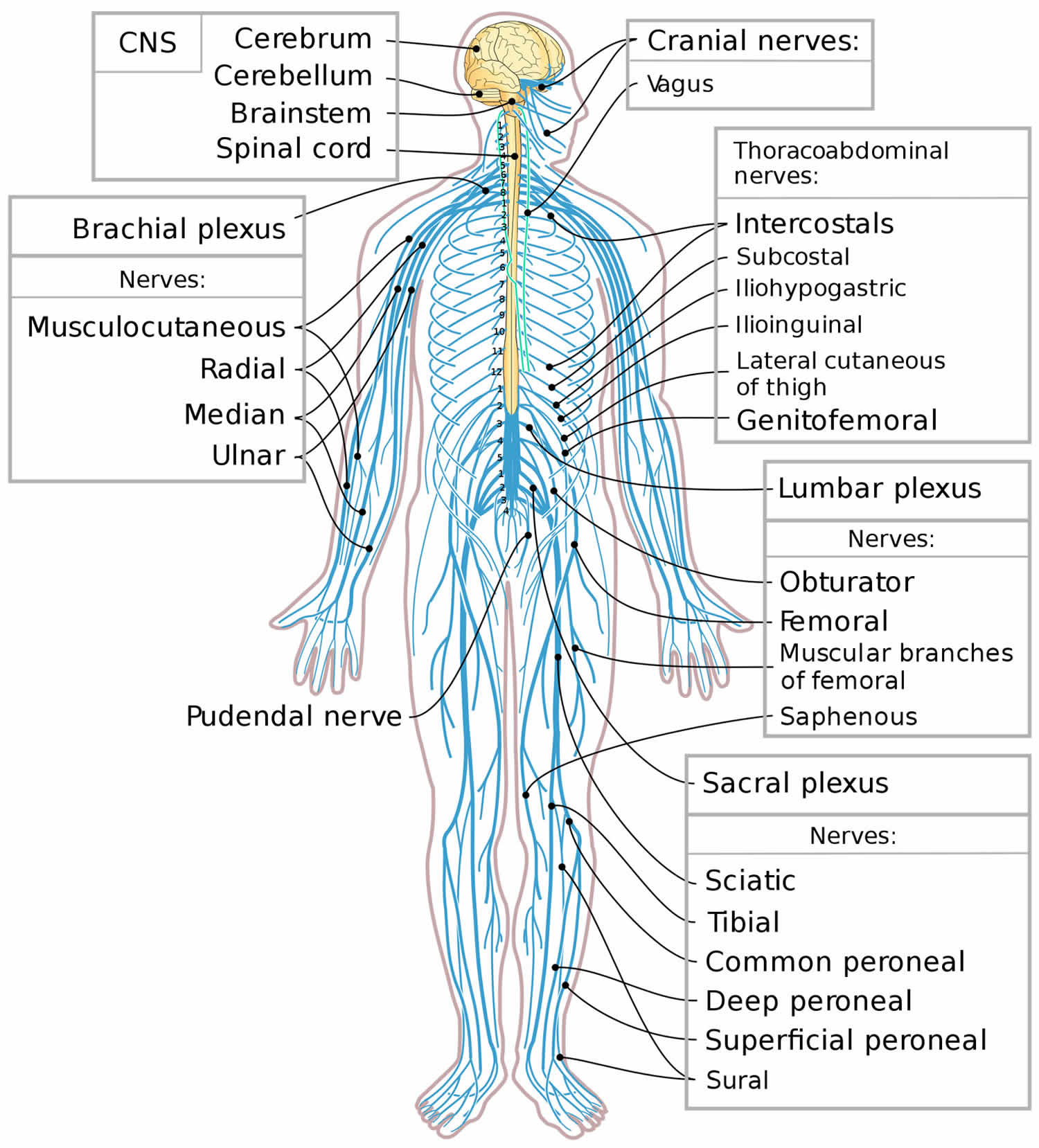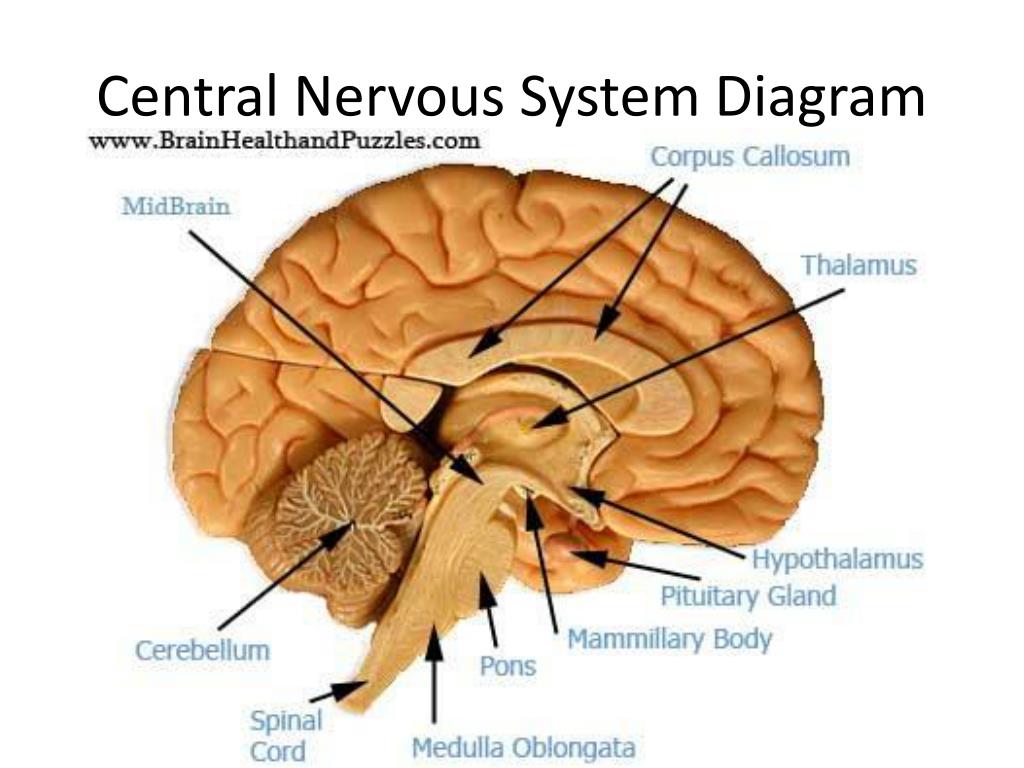Central Nervous System Diagram | Dura mater, arachnoid mater, and pia mater. It generates, modulates and transmits information in the human body. The cns, which comprises the brain and the spinal cord, has to process different types of incoming sensory information. The central nervous system (cns), working in tandem with the peripheral nervous system, allow the body to control and react to stimuli. The peripheral nervous system (pns) concerns all the nervous system outside the central nervous system and contains motor and sensory nerves which transmit information to and from the body and brain.
The central nervous system consists of the brain and the spinal cord. The cns is so named because the brain integrates the received information and coordinates and influences the activity of all parts of the bodies of bilaterally symmetric animals—i.e. Damage to the brain can be caused by many things, for example, trauma and als. Central nervous system (cns) the cns is the brain and the spinal cord. But some scientists have classified them into two divisions in which the ans is included under peripheral nervous system category.

The central nervous system (cns). Browse nervous system templates and examples you can make with smartdraw. Assessment | biopsychology | comparative | cognitive | developmental | language | individual differences | personality | philosophy | social | methods | statistics | clinical | educational | industrial | professional items | world psychology |. The central nervous system (cns) consists of the brain and spinal cord. The peripheral nervous system (pns) concerns all the nervous system outside the central nervous system and contains motor and sensory nerves which transmit information to and from the body and brain. The nervous system, through the use of neurons, make human beings aware of their environment as well as their own bodily needs. This was an overview of the human nervous system function and structure along with a labeled diagram. The autonomic nervous system is, in turn, divided into the sympathetic and parasympathetic nervous system. The nervous system is mainly divided into central nervous system, peripheral nervous system and autonomic nervous system. Dura mater, arachnoid mater, and pia mater. The cns is so named because the brain integrates the received information and coordinates and influences the activity of all parts of the bodies of bilaterally symmetric animals—i.e. Ion channels open, allowing potassium ions to enter. The central nervous system (cns) includes the brain and spinal cord (see figure below ).
The nervous system enables humans to react to their surroundings and to coordinate their behaviour. The peripheral nervous system (pns) concerns all the nervous system outside the central nervous system and contains motor and sensory nerves which transmit information to and from the body and brain. The nervous system is the part of an animal's body that coordinates its voluntary and involuntary actions and transmits signals to and from different parts of its body. Neuroinflammation, autonomic nervous system dysfunction. The autonomous nervous system conveys signals that regulate the internal environment by controlling smooth and cardiac muscles and the organs of the gastrointestinal.

Together with the peripheral nervous system (pns), the other major portion of the nervous system. The central nervous system (cns) is that portion of the vertebrate nervous system that is composed of the brain and spinal cord. The peripheral nervous system consists of sensory neurons, ganglia (clusters of neurons) and nerves that connect the central nervous system to arms. The central nervous system (cns) consists of the brain and spinal cord. The retina, optic nerve, olfactory nerves, and olfactory epithelium are sometimes considered to be part of the cns alongside the brain and spinal cord. Assessment | biopsychology | comparative | cognitive | developmental | language | individual differences | personality | philosophy | social | methods | statistics | clinical | educational | industrial | professional items | world psychology |. This diagram shows the components of the central nervous system. The central nervous system or cns include the brain and spinal cord. The cns takes signals from the peripheral. The cns is the site for processing the information. The cns is responsible for the control of thought processes, movement, and provides sensation central nervous system (cns) definition. As such, the olfactory epithelium is the only central nervous tissue in direct contact with the environment, which opens up for therapeutic treatments. It comprises the brain and spinal cord.
Provides protection of cns and blood vessels, contains csf. It gathers information from all over the body and coordinates activity. It consists of the brain, spinal cord and the retinas of the eyes. Want to learn more about it? White matter and gray matter.

The central nervous system (cns), working in tandem with the peripheral nervous system, allow the body to control and react to stimuli. The central nervous system consists of the brain and the spinal cord. White matter and gray matter. Damage to the brain can be caused by many things, for example, trauma and als. This diagram shows the components of the central nervous system. The central nervous system is ingeniously designed to respond to stimuli both internally and externally. Oligodendrocytes in the central nervous system (unlike the schwann cells in the peripheral nervous system) form segments of myelin sheaths of numerous neurons at once. The central nervous system or cns include the brain and spinal cord. The nervous system is mainly divided into central nervous system, peripheral nervous system and autonomic nervous system. It consists of the brain, spinal cord and the retinas of the eyes. The central nervous system is the integration and command center of the body. The nervous system enables humans to react to their surroundings and to coordinate their behaviour. Find the perfect central nervous system diagram stock illustrations from getty images.
Central Nervous System Diagram: Assessment | biopsychology | comparative | cognitive | developmental | language | individual differences | personality | philosophy | social | methods | statistics | clinical | educational | industrial | professional items | world psychology |.
No comments:
Post a Comment